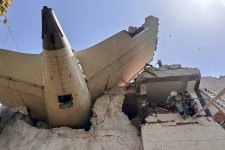Boeing returns to crisis-mode as India crash poses new test
Author of the article:Bloomberg News
Bloomberg News
Julie Johnsson
Published Jun 13, 2025 • 4 minute read
061325-INDIA_AIR_INDIA_CRASH
The crash site of Air India Ltd. Flight 171 in Ahmedabad India.
(Bloomberg) — Boeing Co. Chief Executive Officer Kelly Ortberg finds himself in a painfully familiar role as he faces another crisis, this time over a crash involving the company’s marquee 787 Dreamliner jet in India that killed more than 240 people.
In his first nine months at Boeing, Ortberg has led the company through the early stages of a turnaround. He’s also navigated a cash crunch, debilitating labour unrest, a rush to overhaul the company’s safety operations, and a trade war wrought by President Donald Trump against one of Boeing’s biggest customers: China.
But just as Ortberg looked poised to be gaining momentum and earning cautious praise for the discipline and rigor he brought to the long-troubled company, a horrifying crash of an Air India 787 bound for London served as a reminder of how swiftly confidence in the planemaker can erode.
Boeing shares fell 2.2% at 9:48 am in New York, as the uncertainty sparked by tragedy continued to concern investors. Only one passenger out of the 242 people on board survived the accident, which once again associated the planemaker with safety concerns. Airlines around the globe meanwhile waited to to see if regulators would demand new inspections of 787 Dreamliner fleet, or even a grounding, though the cause of the crash remains unknown for now.
“It’s a classic moment of crisis management and fast response: getting out there and sending teams to understand what happened, and just being there to reassure people,” aerospace consultant Richard Aboulafia said of the initial tasks for Boeing. “A lot of life is just showing up.”
Ortberg and Boeing commercial aircraft head Stephanie Pope spent the initial hours after the tragedy reaching out to Air India executives, “to offer our full support,” the CEO told employees in a memo viewed by Bloomberg.
The Boeing executives also scrapped plans to travel to the Paris Air Show next week, where they’d been expected to showcase Boeing’s progress and unveil orders. GE Aerospace, which made the engines on the doomed Dreamliner, cancelled a June 17 investor day in Paris.
“Safety is foundational to our industry and is at the core of everything that we do,” Ortberg told employees. “Please keep the families and loved ones affected by this accident in your thoughts.”
It will take investigators weeks, if not months, to sort through the evidence and pinpoint what caused the first fatal crash for Boeing’s 787 Dreamliner. That’s likely to keep the spotlight on Ortberg and Boeing’s safety record, rather than the progress in the factories toward returning to pre-pandemic manufacturing rates.
The Air India Dreamliner rolled down almost the entire length of an 11,000-foot runway before lumbering in the air, according to data from FlightRadar24. It only gained about 625 feet of altitude before sinking to the ground with its nose up, suggesting an aerodynamic stall, said aviation consultant Robert Mann.
There were several puzzling aspects, including the configuration of the plane’s flight surfaces and landing gear — which wasn’t retracted.
“It was clearly a case where it was not accelerating and should have been obvious early enough you just reject the takeoff,” Mann said.
Investigators will examine what might have caused the loss of power — whether from a bird strike, contaminated fuel, maintenance or pilot error, or some other factor. They say it’s less likely the crash was related to the design and build of the 787 itself, which had been flying for Air India for more than 11 years.
Even still, for Boeing executives “it’s going to be a very tense 24 hours,” Aboulafia said.
Ortberg, a low-key Midwesterner and engineer by training, came out of retirement last year to take on one of the tougher turnarounds in corporate America. Boeing was reeling from a near-catastrophe on an airborne 737 Max that spurred investigations, a crackdown by US regulators and a leadership exodus.
He’s kept a low public profile while preaching internally the importance of instilling a culture that emphasizes civility, respect and pride in workmanship. A working group of employees, formed to craft a statement of values, insisted on urging Boeing’s workforce to “give a damn.”
Boeing customers like John Plueger, the chief executive officer of Air Lease, the largest US aircraft financier, have noticed a difference. The manufacturer’s planes are arriving on time, after years of chronic delays, Plueger said in an interview last month. The company’s jet factories and supply chain seem to have fewer disruptions and quality breakdowns, although they’re still a concern, he said.
The US planemaker even enjoyed the momentum of a record order placed by Qatar Airways during a visit by Trump, which propelled its May orders to the highest such tally in about 18 months.
That momentum risks stalling as the company works to find out what role, if any, Boeing played in the crash.
Follow Bloomberg India on WhatsApp for exclusive content and analysis on what billionaires, businesses and markets are doing. Sign up here.
The plane at the center of the tragedy was built during the early days of the 787 program, when Boeing was struggling with the consequences of a decision to offload much of the design and development work to suppliers in order to cut costs. The Dreamliner was the 26th to roll off Boeing’s line, placing it among the 60 early aircraft that required extensive rework after they’d rolled out of Boeing’s factory north of Seattle.
The early turbulence of the 787 Dreamliner had faded as the carbon-composite jet settled into a mostly steady performer for carriers from ANA Holdings Inc. to United Airlines Holdings Inc.
While Plueger has confidence in the company’s leadership, “Boeing is not completely out of the woods,” he said.
“It needs to consistently deliver and consistently demonstrate high quality production with no real glitches or problems or safety concerns.”
— With assistance from Mary Schlangenstein.
Boeing Co. Chief Executive Officer Kelly Ortberg finds himself in a painfully familiar role as he faces another crisis

torontosun.com







